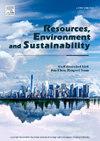1980-2030年中国城市水系温室气体排放轨迹、驱动因素及减排
IF 7.8
Q1 ENVIRONMENTAL SCIENCES
引用次数: 0
摘要
城市水系统(UWSs)随着城市人口、技术进步和生活方式的变化而不断发展,导致温室气体(GHG)排放发生重大变化。了解温室气体排放在UWS不同发展阶段的变化,对于绘制不同城市化水平和基础设施成熟度下的碳中和路径至关重要。为了探索UWS温室气体排放的长期模式,我们开发了一个系统的核算框架,包括四个与能源相关的子系统:取水、供水、住宅用水和废水处理。我们将这一框架应用于中国大学在省级层面的过渡轨迹——从早期发展到全系统成熟(1980-2020)。结果表明,在过去的40年中,中国UWS的温室气体排放量增长了约14倍,超过整体人口增长率143.9%。从20世纪90年代初至今,居民用水成为uws相关排放的主要来源,约占总排放量的77.6%。我们的情景分析估计,通过节水战略,到2030年中国的碳排放量可能减少34.0%(1.283亿吨二氧化碳当量)。本研究为促进水系统的低碳运营和可持续管理提供了重要见解,并为全球实现水基础设施净零提供了重要参考。本文章由计算机程序翻译,如有差异,请以英文原文为准。

Trajectory, drivers, and reduction of greenhouse gas emissions from urban water system in China during 1980–2030
Urban water systems (UWSs) continuously evolve in response to changes in urban populations, technological advancements, and lifestyle shifts, resulting in significant changes in greenhouse gas (GHG) emissions. Understanding how GHG emissions vary across the different developmental stages of a UWS is crucial for charting pathways toward carbon neutrality under varying levels of urbanization and infrastructure maturity. To explore the long-term patterns of GHG emissions from the UWS, we developed a systematic accounting framework encompassing four energy-related subsystems: water extraction, water supply, residential water use, and wastewater treatment. We applied this framework to China’s UWS across its transitional trajectory—from early development to system-wide maturity (1980–2020) at the provincial level. Results show that over the 40 years, GHG emissions from China’s UWS increased approximately 14-fold, surpassing the overall rate of population growth by 143.9%. From the early 1990s till now, residential water use emerged as the dominant source of UWS-related emissions, accounting for approximately 77.6% of total emissions. Our scenario analysis estimates a potential 34.0% reduction in China’s carbon emissions (128.3 Mt CO2-eq) by 2030 through water-saving strategies. This study offers critical insights into promoting low-carbon operations and sustainable management of UWS, and serves as an important reference for global efforts net-zero water infrastructure.
求助全文
通过发布文献求助,成功后即可免费获取论文全文。
去求助
来源期刊

Resources Environment and Sustainability
Environmental Science-Environmental Science (miscellaneous)
CiteScore
15.10
自引率
0.00%
发文量
41
审稿时长
33 days
 求助内容:
求助内容: 应助结果提醒方式:
应助结果提醒方式:


